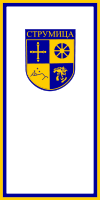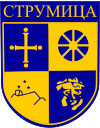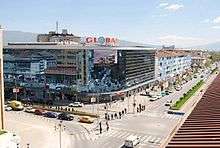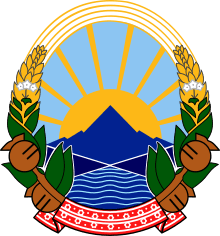Strumica
Strumica (Macedonian: Струмица [ˈstrumit͡sa] (![]()
Strumica | |
|---|---|
.jpg) | |
 Flag  Coat of arms | |
 Strumica Location within North Macedonia | |
| Coordinates: 41°26′20″N 22°38′20″E | |
| Country | |
| Region | |
| Municipality | |
| Government | |
| • Mayor | Kosta Janevski (SDSM) |
| Elevation | 230 m (750 ft) |
| Population (2002) | |
| • Total | 35,311 |
| Time zone | UTC+1 (CET) |
| • Summer (DST) | UTC+2 (CEST) |
| Postal code | 2400 |
| Area code(s) | +389 34 |
| Car plates | SR |
| Patron saints | Holy Fifteen Hieromartyrs of Tiberiopolis |
| Climate | Cfa |
| Website | www.strumica.gov.mk |
Name
The town is first mentioned in the 2nd century BC with the Greek name Αστραίον (Astraîon, "starry")[2] by Ptolemy and Pliny. It was known as Tiberiopolis in Roman times, and received its present name from the Slavic settlers of the Middle Ages. In Turkish the town is known as Ustrumca, and in modern Greek Στρώμνιτσα (Strómnitsa). In Bulgarian the name is as in Macedonian - Струмица.
Geography
Strumica is located in the southeastern part of the country, close to the borders with Greece (15 km) and Bulgaria. It is situated in the geographical region of the Strumica Field, where the field meets the highland elevating into the Plavuš (west) and Belasica (south) mountains. The Struma river flows north of the city, while several tributaries flow through the city area.
Climate
Strumica has a humid subtropical climate (Köppen climate classification: Cfa).
| Climate data for Strumica | |||||||||||||
|---|---|---|---|---|---|---|---|---|---|---|---|---|---|
| Month | Jan | Feb | Mar | Apr | May | Jun | Jul | Aug | Sep | Oct | Nov | Dec | Year |
| Average high °C (°F) | 5.6 (42.1) |
9.0 (48.2) |
13.4 (56.1) |
18.4 (65.1) |
23.6 (74.5) |
28.2 (82.8) |
30.6 (87.1) |
30.4 (86.7) |
26.8 (80.2) |
20.0 (68.0) |
12.2 (54.0) |
7.2 (45.0) |
18.8 (65.8) |
| Daily mean °C (°F) | 2.1 (35.8) |
4.7 (40.5) |
8.4 (47.1) |
12.8 (55.0) |
17.6 (63.7) |
21.7 (71.1) |
23.7 (74.7) |
23.5 (74.3) |
20.1 (68.2) |
14.5 (58.1) |
8.2 (46.8) |
3.7 (38.7) |
13.4 (56.2) |
| Average low °C (°F) | −1.3 (29.7) |
0.4 (32.7) |
3.4 (38.1) |
7.2 (45.0) |
11.6 (52.9) |
15.2 (59.4) |
16.9 (62.4) |
16.6 (61.9) |
13.4 (56.1) |
9.1 (48.4) |
4.2 (39.6) |
0.3 (32.5) |
8.1 (46.6) |
| Average precipitation mm (inches) | 33 (1.3) |
33 (1.3) |
36 (1.4) |
37 (1.5) |
52 (2.0) |
41 (1.6) |
33 (1.3) |
29 (1.1) |
28 (1.1) |
39 (1.5) |
54 (2.1) |
44 (1.7) |
459 (17.9) |
| Source: Climate-Data.org [3] | |||||||||||||
History
Ancient period
According to archeological findings, settlement of the area dates back to 6000–5000 BC: a Neolithic settlement (Stranata) located near the village of Angelci, as well as findings from the Emperor's Towers site near Strumica, where traces of a prehistoric culture existed from the early 4th to mid 3rd millennium BC were discovered. The area was populated later by the Paionians.
The first mention of the city under the name Astraion is in the writings of the Roman historian Titus Livius in 181 BC regarding the execution of Demetrius, brother of the Ancient Macedonian king Perseus (179–168 BC), son of Philip V of Macedon (221–179 BC). The name Astraion came from the Paionian tribe called Astrai. In 148 BC the region became a Roman province. In the Roman period the city changed its name to Tiberiopolis, which is evidenced by a marble statue base dedicated to the patron Tiberius Claudius Menon, who lived between the late 2nd and early 3rd century AD. During the reign of the Roman emperor Julian the Apostate (361–363 AD), the fifteen holy hieromartyrs of Tiberiopolis were killed. In 395, the Roman Empire split, and Macedonia fell under the Eastern Roman Empire (the Byzantine Empire). After that, Tiberiopolis became part of the province Macedonia Salutaris or Macedonia Secunda in the late 4th century. The urban mansion Machuk dating from the late ancient period today stands witness for the existence of a city settlement from that time.
Middle Ages
In the 6th and 7th centuries, the Roman town became subject of Slavic migration . The Strymonites, a Sclaveni tribe, adopted their name after the Strymon river (Struma). The Strymonites were independent until the 9th century, followed by a Byzantine reconquest. Later on, the Strumica region was conquered by Bulgarian Khan Presian (836–852). The Strumica region remained part of the Bulgarian state throughout a period of more than 150 years right up until 1014, when it was retaken by the Byzantines. In the 11th century, written sources begin to refer to the town with its Slavic name as Strumica.
By the end of the 12th century, the Byzantine central power had weakened and, as a result, many local lords broke away and became independent. Initially, the leader of the Vlachs and Bulgarians in eastern Macedonia Dobromir Chrysos (1185–1202) and later the Bulgarian sebastokrator and a member of the Asen dynasty in Veliko Tarnovo Strez (1208–1214) held the region, which became part of the Bulgarian kingdom in 1202. In the second half of the 13th century the city was recovered by the Byzantine Empire until the Serbian Kingdom conquered the region in the 14th century. Serbian magnate Hrelja ruled Strumica and the nearby region until 1334, when it was put under the direct rule of Serbian King Stefan Dušan who continued his conquest to the south. During the Fall of the Serbian Empire, the Strumica region was first ruled by Uglješa, the brother of magnate Vukašin. Strumica itself was then governed by Dabiživ Spandulj, who served the Dejanović brothers. The Ottoman Empire finally conquered Strumica in 1383.
Ottoman period
Under Ottoman administration, the town was named Üstrümce. It belonged to the Sanjak of Kyustendil, and the timarli-sipahi system was established. Nomads and livestock breeders of Turkic origin were settled, which altered the general look of the city making it more oriental. According to the census of 1519, Strumica had a population of 2,780, of which 1,450 were Christians and 1,330 were Muslims. These were times when conversion to Islam was at its peak in the region, which accounts for the increased number of Muslims (2,200) compared to Christians (1,230) according to the census of 1570.
In the 17th century, it became seat of a kadiluk. At about this time, Strumica was visited by the Ottoman travel writers Haji Kalfa (1665) and Evliya Çelebi (1670), who gave a description of the city and all its Islamic buildings. In the late 18th and early 19th century, Strumica was part of the Sanjak of Salonica. During the 19th century the influence of the Patriarchate of Constantinople increased, and so did the number of pro-Greek citizens. Countering this, the Bulgarian Exarchate found support in the Slavic populace; the first Bulgarian school in the Strumica region was opened in Robovo in 1860, and its first teacher was Arseni Kostencev from Štip. This period coincided with the work of the great fresco masters from Strumica – Vasil Gjorgiev and Grigorij Petsanov. They did work in many churches built in the Strumica region at the time. In the late 19th and early 20th century, Strumica was part of the Salonica Vilayet.
Late-19th century
Following the Berlin Congress of 1878, when the Ottoman Empire lost a sizable portion of its territory on the Balkans, a stream of refugees flowed into the area; some of them ending up in Strumica. These people were called "muhajirs". According to the Ottoman General Census of 1881/82-1893, the kaza of Strumica had a total population of 33.024, consisting of 15.760 Muslims, 13.726 Greeks, 2.965 Bulgarians and 573 Jews.[4]
The Internal Macedonian Revolutionary Organization for the Ograzden county was formed and operated in these parts. One of the most prominent leaders of the organization in Strumica was Hristo Chernopeev, who took part in the Young Turk Revolution (1908–09). The outcome of this effort did not bring freedom to the local people who still remained under Ottoman rule.
20th century
The Kaza of Strumica in 1905 had a total Christian population of 22.860, consisting of 12.736 Exarchist Bulgarians, 8.992 Patriarchist Bulgarians, 624 Protestant Bulgarians, 444 Roma people, 25 Greeks and 6 Vlachs according to the geographers Dimitri Mishev and D. M. Brancoff.[5]
In the First Balkan War of 1912 the Ottomans were defeated and driven out of Macedonia (region) by the joint effort of the Balkan League (Serbia, Bulgaria, Greece and Montenegro). Bulgaria annexed the town of Strumica. In the Second Balkan War (1913), which was fought between the three of the Balkan allies against Bulgaria, the latter was defeated, however, according to the Bucharest treaty (28 July 1913) Strumica remained under Bulgarian rule. The Greek army stationed in Strumica disapproved of the decision for withdrawal and set the town on fire. It burned from 8 until 15 August 1913, when more than 1900 public buildings, private houses and other constructions were burnt.[6] Strumica was made the center of a homonymous district in Bulgaria (largely corresponding to the present day Blagoevgrad province)[7] and stayed under Bulgarian rule until 1919, when it was ceded to the Kingdom of Serbs, Croats and Slovenes after the Treaty of Neuilly-sur-Seine. From 1929 to 1941, Strumica was part of the Vardar Banovina of the Kingdom of Yugoslavia.
On 6 April 1941, the first day of the Axis invasion of Yugoslavia, Strumica was captured by the German Army and, as Bulgaria was allied with Germany, Strumica was turned over under occupation of the Bulgarian armies on 18 April 1941. From 1941 to 1944, Strumica, as most of Vardar Macedonia, was annexed by the Kingdom of Bulgaria. On 11 September 1944 the Bulgarian army withdrew from Strumica and on 5 November 1944, the German army also left the town. After the war it became part of the Socialist Republic of Macedonia, one of the republics of Federal Yugoslavia. With the referendum on 8 September 1991, amid the breakup of Yugoslavia, the country became independent under the constitutional name Republic of Macedonia.
Economy

Strumica is the main agricultural center in North Macedonia. It has food industry, textile factories and a developed domestic and international trade network.
Education
The city of Strumica has four primary schools: Vidoe Podgorec, Sando Masev, Marshal Tito and Nikola Vapcarov; three high schools: Jane Sandanski, Nikola Karev and Dimitar Vlahov; one dispersed university Goce Delcev, which has three faculties, including Teacher Training, Economic, and Agriculture; first private university "FON," which has six faculties, including Law, Economy, Sport Management, Detectives and Security, Communication and IT, Foreign Languages; and a music school Boro Dzoni.
Sport
Football
There are few main football clubs. In 2017 year Akademija Pandev will be in elite division Macedonian First League. FK Horizont Turnovo plays in the Macedonian Second League, while FK Belasica play in the Second and FK Tiverija in the Third.
Also women's team of FK Tiverija plays in first division.
Basketball
The first two clubs in independent Macedonia was Makedonija 91 and Nemetali Ograzden. Two basketball clubs train and play in Strumica after reorganization of KK Strumica 2005: KK Aba and KK Milenium. These days only one club is in Second Macedonian Basketball Division - KK Strumica.
Media
There is one private local TV stations - TV kanal VIS and two radio stations, Ekspres radio and Hit Radio and two cable TV providers: NetCable and Telekabel.
Population
The population of the municipality of Strumica is 54,676.[8]
- Macedonians: 50,258 / 91.9%
- Macedonian Muslims: 3,754 / 6.8%
- Macedonian Others: 1.3%
Notable people
- Boris Trajkovski, former Macedonian president
- Goran Trenchovski, Macedonian director and writer
- Evangelos Koukoudeas, Greek chieftain of the Macedonian Struggle
- Zoran Zaev, Prime-Minister of North Macedonia
- Vančo Stojanov, Macedonian athlete
- Kiro Stojanov, Catholic bishop
- Blagoj Mučeto, Yugoslav partisan
- Haralampos Boufidis, Greek chieftain of the Macedonian Struggle
- Zoran Madžirov, Macedonian musician
- Goran Maznov, Macedonian footballer
- Goran Pandev, Macedonian footballer
- Goran Popov, Macedonian footballer
- Baba Vanga, Bulgarian clairvoyant
- Dimitrios Semsis, Greek violinist
- Veljko Paunović, Serbian footballer
- Igor Gjuzelov, Macedonian footballer
- Jani Atanasov, Macedonian footballer
Gallery
 Monument Macedonia dedicated to the second president of the Republic of Macedonia, Boris Trajkovski
Monument Macedonia dedicated to the second president of the Republic of Macedonia, Boris Trajkovski Strumica Clock Tower
Strumica Clock Tower Goce Delčev statue
Goce Delčev statue.jpg) World map fountain at Goce Delčev Square
World map fountain at Goce Delčev Square The Strumica Lake
The Strumica Lake The Strumica Amphitheatre
The Strumica Amphitheatre Strumica Town Hall
Strumica Town Hall
References
- 2002 census results in English and Macedonian (PDF)
- Branigan, Keith (1992). Lexicon of the Greek and Roman cities and place names in antiquity, ca. 1500. Adolf M. Hakkert. ISBN 90-256-0985-6.. Text says "Unlocated town in Macedonia, also called Astraion, mentioned by Ptolemy and Pliny"
- "Climate: Strumica". Climate-Data.org. Retrieved January 30, 2018.
- Kemal Karpat (1985), Ottoman Population, 1830-1914, Demographic and Social Characteristics, The University of Wisconsin Press, p. 134-135
- Dimitri Mishev and D. M. Brancoff, La Macédoine et sa Population Chrétienne, p. 158
- Paul Mojzes, Yugoslavian Inferno: Ethnoreligious Warfare in the Balkans, Bloomsbury Academic Publishing, 2016, ISBN 1474288383, p. 46.
- Chronicle of the formation of regions in Bulgaria (in Bulgarian) (DOC)
- Државен завод за статистика: Попис на населението, домаќинствата и становите во Република Македонија, 2002: Дефинитивни податоци (PDF) (in Macedonian)

